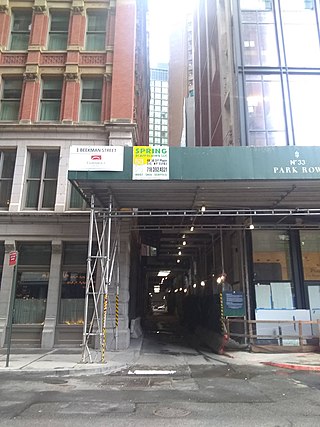
New York City Hall is the seat of New York City government, located at the center of City Hall Park in the Civic Center area of Lower Manhattan, between Broadway, Park Row, and Chambers Street. Constructed from 1803 to 1812, the building is the oldest city hall in the United States that still houses its original governmental functions, such as the office of the Mayor of New York City and the chambers of the New York City Council. While the Mayor's Office is in the building, the staff of thirteen municipal agencies under mayoral control are located in the nearby Manhattan Municipal Building, one of the largest government buildings in the world, with many others housed in various buildings in the immediate vicinity.

Collect Pond, or Fresh Water Pond, was a body of fresh water in what is now Chinatown in Lower Manhattan, New York City. For the first two centuries of European settlement in Manhattan, it was the main New York City water supply system for the growing city. The location of the former pond later became the site of a jail, and is now memorialized by Collect Pond Park, which includes a reflecting pool to acknowledge the historic importance of this body of water.

The written history of New York City began with the first European explorer, the Italian Giovanni da Verrazzano in 1524. European settlement began with the Dutch in 1608.

During the American Revolutionary War (1775–1783), management and treatment of prisoners of war (POWs) were very different from the standards of modern warfare. Modern standards, as outlined in the Geneva Conventions of later centuries, assume that captives will be held and cared for by their captors. One primary difference in the 18th century was that care and supplies for captives were expected to be provided by their own combatants or private resources.
Edwin G. "Ted" Burrows was a Distinguished Professor of History at Brooklyn College. He is the co-author of the Pulitzer Prize-winning Gotham: A History of New York City to 1898 (1998), and author of Forgotten Patriots: The Untold Story of American Prisoners During the Revolutionary War, (2008), which won the 2009 Fraunces Tavern Museum Book Award.

Paulus Hook is a community on the Hudson River waterfront in Jersey City, New Jersey. It is located one mile across the river from Manhattan. The name Hook comes from the Dutch word "hoeck", which translates to "point of land." This "point of land" has been described as an elevated area, the location of which today is bounded by Montgomery, Hudson, Dudley, and Van Vorst Streets.

The Great Fire of New York was a devastating fire that burned through the night of September 20, 1776, and into the morning of September 21, on the West Side of what then constituted New York City at the southern end of the island of Manhattan. It broke out in the early days of the military occupation of the city by British forces during the American Revolutionary War.

City Hall Park is a public park surrounding New York City Hall in the Civic Center of Manhattan. It was the town commons of the nascent city of New York.
David Mathews was an American lawyer and politician from New York City. He was a Loyalist during the American Revolutionary War and was the 43rd and last Colonial Mayor of New York City from 1776 until 1783. As New York City was the center of British control of the Colonies during the war, he was one of the highest ranking civilian authorities in the Colonies during this period. He was accused of supporting a plan led by Thomas Hickey to kill the Revolutionary General George Washington. He resettled in Nova Scotia after the war, and became a leading political figure in the Cape Breton colony that was created in 1786.


Sugar houses in New York City were used as prisons by occupying British forces during the American Revolutionary War. Out of 2,600 prisoners of war captured during the Battle of Fort Washington in November 1776, 1,900 would die in the following months at makeshift prisons throughout the city. At least 17,500 are estimated to have perished under substandard conditions of such sugar houses and British prison ships over the course of the war, more than double the number of killed from battle.

The Brick Presbyterian Church is a large congregation at Park Avenue and 91st Street on the Upper East Side of Manhattan in New York City. A member of the Presbyterian Church, it is known for its Day School and music programs. It was founded as an offshoot of First Presbyterian Church. Its first building, in Lower Manhattan, opened in 1768. The Park Avenue location opened April 14, 1940.

McKenna Square is a 0.24-acre public green space in the Washington Heights neighborhood of Upper Manhattan in New York City. The park is located in a median of West 165th Street, between Audubon and Amsterdam Avenues. The triangular site was created in 1917 in conjunction of the widening of West 165th Street and was transferred to Parks in 1937.

Theatre Alley is a block-long cobblestone alley in the Financial District of Manhattan, New York City, between Ann and Beekman Streets. It is one of Manhattan's few alleys that is not privately owned, and prior to the expansion of 5 Beekman Street adjacent to the alley c. 2010, it was "dank and claustrophobic".

















